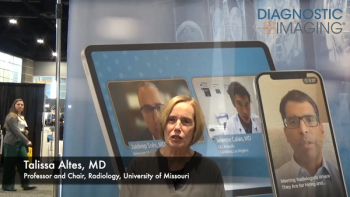
Siemens unveils wide-bore MR scanners at RSNA 2009
Siemens brought two blockbuster MR offerings to the RSNA meeting this week: the 3T Skyra and 1.5T Aera. The two new products, works-in-progress pending FDA clearance but scheduled to begin shipping by mid-2010, promise a productivity lift through their patient-friendly bores, measuring 70 cm wide, and automation that simplifies complex scan tasks.
Siemens brought two blockbuster MR offerings to the RSNA meeting this week: the 3T Skyra and 1.5T Aera. The two new products, works-in-progress pending FDA clearance but scheduled to begin shipping by mid-2010, promise a productivity lift through their patient-friendly bores, measuring 70 cm wide, and automation that simplifies complex scan tasks.
The 70-cm bores add to productivity by reducing anxiety, thereby reducing the chance that patients will stop the exam before it's done. It also provides the room to do obese patients. Adding to patient comfort are the short cylinders of each new scanner, which allow many studies to be completed with the patient's head outside the bore.
The simplification built into the operation of the scanners makes image quality less dependent on the skill of the technologist running the machines. In preliminary testing at one site in the U.K., Siemens found that the automation built into the Skyra and Aera scanners expanded the number of technologists able to do cardiac MR exams from two to 14.
"We will have to prove this by studies but we believe that the whole setup (of software with Aera or Skyra) will increase productivity up to 30%," said Walter Märzendorfer, CEO of MR Imaging at Siemens Healthcare.
Clinical experience so far has been mostly limited to piecemeal software tests conducted using other MR scanners in the Siemens portfolio, although Märzendorfer expects three sites to begin running either Aera or Skyra very soon.
The premium 1.5T and 3T scanners will demand premium prices in their field strengths, he said. Sales efforts at the RSNA meeting, however, are framing the two new products as cost-effective answers for high-volume operations.
Many of the advantages coming from Siemens' two new wide-bore MR scanners are due to the company's next-generation Tim (total imaging matrix) technology, which is built into both. This fourth generation (4G) accelerates scans, leveraging ultrahigh-density coils that transmit data through more channels than ever before. The new Tim's patient-adaptive technology further speeds scans by cutting the time needed for setup.
The studies needed to nail down exactly how much this new technology boosts productivity have not yet been carried out, although Siemens execs are adamant they will be done soon. In the meantime, they and their staff will draw from anecdotal information indicating that high-volume MR operations could see a 30% increase in the number of exams per day.
The automation that makes such productivity possible is built into Tim+Dot (day optimizing throughput), which burnishes Siemens' reputation for simplifying complex tasks through patient personalization routines, user guidance, and exam automation. Reducing the dependence of sites on the skill of their technologists increases image consistency and diagnostic confidence while increasing throughput, according to Märzendorfer.
Both systems feature Siemens proprietary TrueForm magnet design, which provides up to 50% more imaging volume. Homogenous images are sharp all the way to the edges of the 50 x 50 x 45-cm field-of-view.
The ultrahigh-density coils featured on these scanners have up to 204 elements. Combined with a new radiofrequency design that includes up to 64 RF channels, the new scanners can achieve a signal-to-noise ratio increase of up to 20%, according to the company. This allows high spatial and temporal resolution that does not degrade when zooming in on images.
Newsletter
Stay at the forefront of radiology with the Diagnostic Imaging newsletter, delivering the latest news, clinical insights, and imaging advancements for today’s radiologists.




























